CADILLAC SRX 2007 1.G Owners Manual
Manufacturer: CADILLAC, Model Year: 2007, Model line: SRX, Model: CADILLAC SRX 2007 1.GPages: 522, PDF Size: 2.71 MB
Page 391 of 522
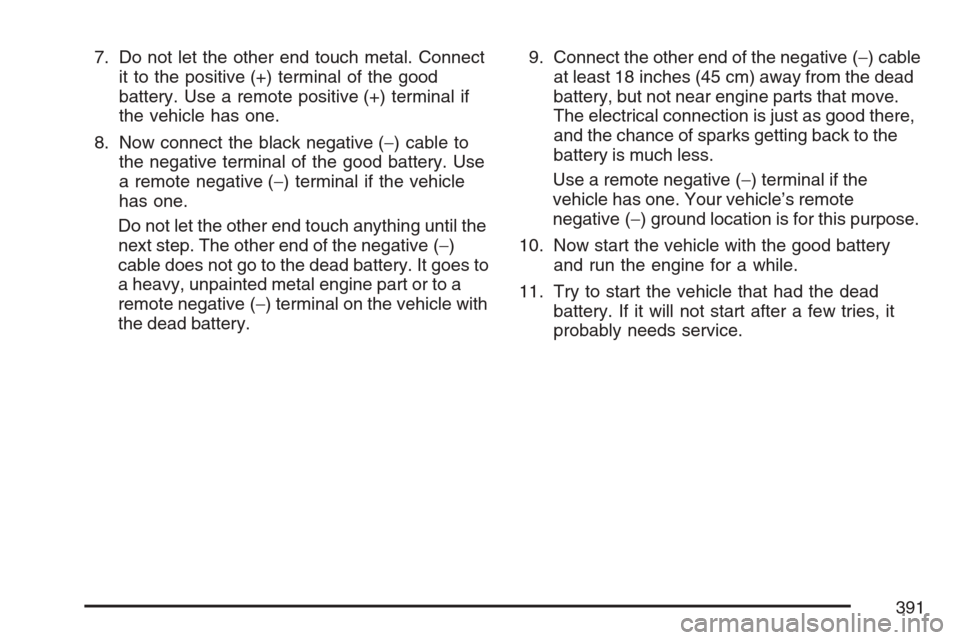
7. Do not let the other end touch metal. Connect
it to the positive (+) terminal of the good
battery. Use a remote positive (+) terminal if
the vehicle has one.
8. Now connect the black negative (−) cable to
the negative terminal of the good battery. Use
a remote negative (−) terminal if the vehicle
has one.
Do not let the other end touch anything until the
next step. The other end of the negative (−)
cable does not go to the dead battery. It goes to
a heavy, unpainted metal engine part or to a
remote negative (−) terminal on the vehicle with
the dead battery.9. Connect the other end of the negative (−) cable
at least 18 inches (45 cm) away from the dead
battery, but not near engine parts that move.
The electrical connection is just as good there,
and the chance of sparks getting back to the
battery is much less.
Use a remote negative (−) terminal if the
vehicle has one. Your vehicle’s remote
negative (−) ground location is for this purpose.
10. Now start the vehicle with the good battery
and run the engine for a while.
11. Try to start the vehicle that had the dead
battery. If it will not start after a few tries, it
probably needs service.
391
Page 392 of 522
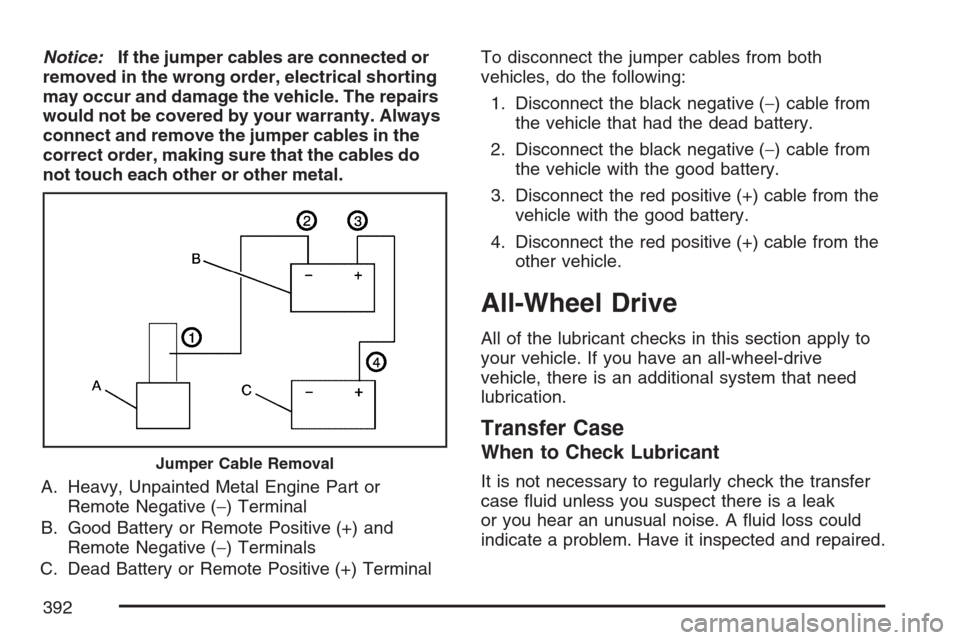
Notice:If the jumper cables are connected or
removed in the wrong order, electrical shorting
may occur and damage the vehicle. The repairs
would not be covered by your warranty. Always
connect and remove the jumper cables in the
correct order, making sure that the cables do
not touch each other or other metal.
A. Heavy, Unpainted Metal Engine Part or
Remote Negative (−) Terminal
B. Good Battery or Remote Positive (+) and
Remote Negative (−) Terminals
C. Dead Battery or Remote Positive (+) TerminalTo disconnect the jumper cables from both
vehicles, do the following:
1. Disconnect the black negative (−) cable from
the vehicle that had the dead battery.
2. Disconnect the black negative (−) cable from
the vehicle with the good battery.
3. Disconnect the red positive (+) cable from the
vehicle with the good battery.
4. Disconnect the red positive (+) cable from the
other vehicle.
All-Wheel Drive
All of the lubricant checks in this section apply to
your vehicle. If you have an all-wheel-drive
vehicle, there is an additional system that need
lubrication.
Transfer Case
When to Check Lubricant
It is not necessary to regularly check the transfer
case �uid unless you suspect there is a leak
or you hear an unusual noise. A �uid loss could
indicate a problem. Have it inspected and repaired.
Jumper Cable Removal
392
Page 393 of 522
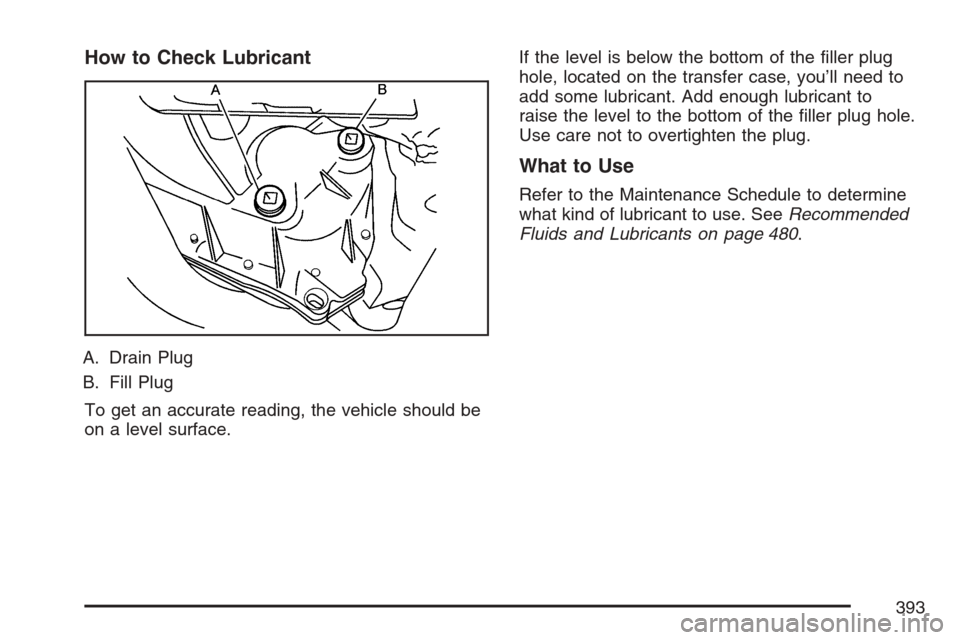
How to Check Lubricant
A. Drain Plug
B. Fill Plug
To get an accurate reading, the vehicle should be
on a level surface.If the level is below the bottom of the �ller plug
hole, located on the transfer case, you’ll need to
add some lubricant. Add enough lubricant to
raise the level to the bottom of the �ller plug hole.
Use care not to overtighten the plug.
What to Use
Refer to the Maintenance Schedule to determine
what kind of lubricant to use. SeeRecommended
Fluids and Lubricants on page 480.
393
Page 394 of 522
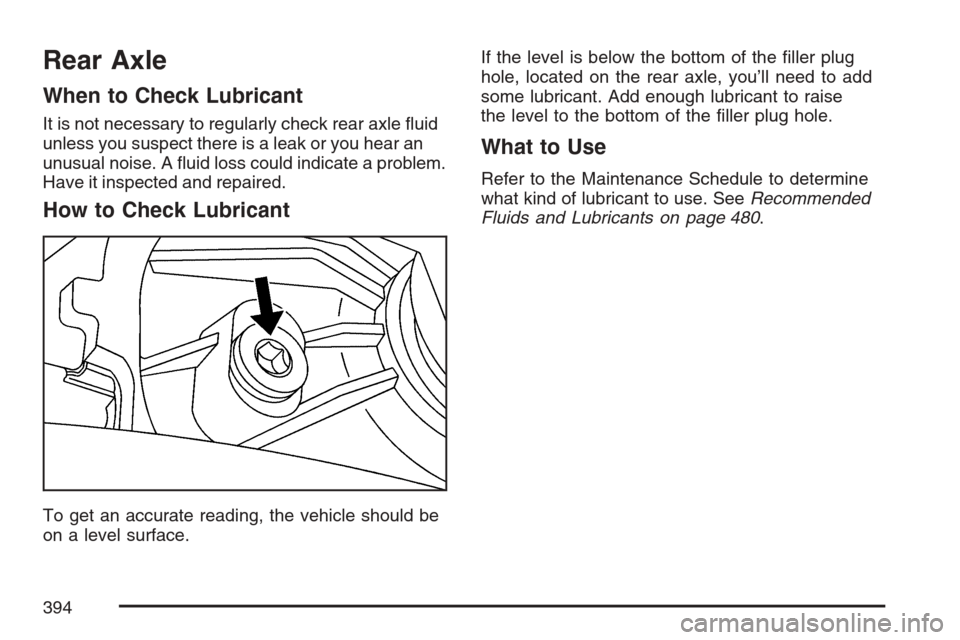
Rear Axle
When to Check Lubricant
It is not necessary to regularly check rear axle �uid
unless you suspect there is a leak or you hear an
unusual noise. A �uid loss could indicate a problem.
Have it inspected and repaired.
How to Check Lubricant
To get an accurate reading, the vehicle should be
on a level surface.If the level is below the bottom of the �ller plug
hole, located on the rear axle, you’ll need to add
some lubricant. Add enough lubricant to raise
the level to the bottom of the �ller plug hole.
What to Use
Refer to the Maintenance Schedule to determine
what kind of lubricant to use. SeeRecommended
Fluids and Lubricants on page 480.
394
Page 395 of 522
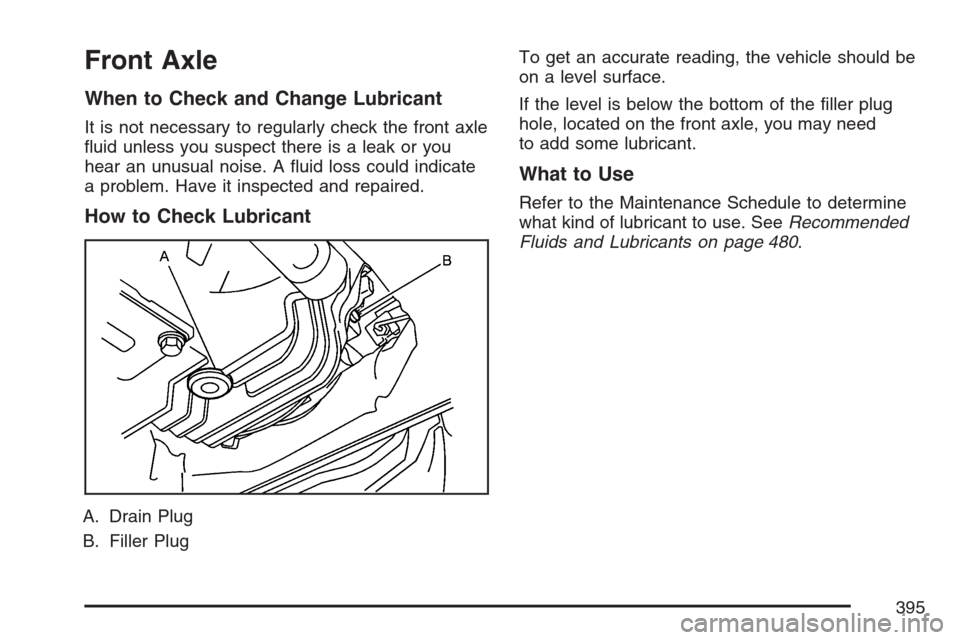
Front Axle
When to Check and Change Lubricant
It is not necessary to regularly check the front axle
�uid unless you suspect there is a leak or you
hear an unusual noise. A �uid loss could indicate
a problem. Have it inspected and repaired.
How to Check Lubricant
A. Drain Plug
B. Filler PlugTo get an accurate reading, the vehicle should be
on a level surface.
If the level is below the bottom of the �ller plug
hole, located on the front axle, you may need
to add some lubricant.
What to Use
Refer to the Maintenance Schedule to determine
what kind of lubricant to use. SeeRecommended
Fluids and Lubricants on page 480.
395
Page 396 of 522

Bulb Replacement
It is recommended that all bulbs be replaced by
your dealer.
High Intensity Discharge (HID)
Lighting
{CAUTION:
The low beam high intensity discharge
lighting system operates at a very high
voltage. If you try to service any of the
system components, you could be
seriously injured. Have your dealer or a
quali�ed technician service them.Your vehicle has HID headlamps. After your
vehicle’s HID headlamp bulb has been replaced,
you may notice that the beam is a slightly different
shade than it was originally. This is normal.
Halogen Bulbs
{CAUTION:
Halogen bulbs have pressurized gas
inside and can burst if you drop or
scratch the bulb. You or others could be
injured. Be sure to read and follow the
instructions on the bulb package.
396
Page 397 of 522
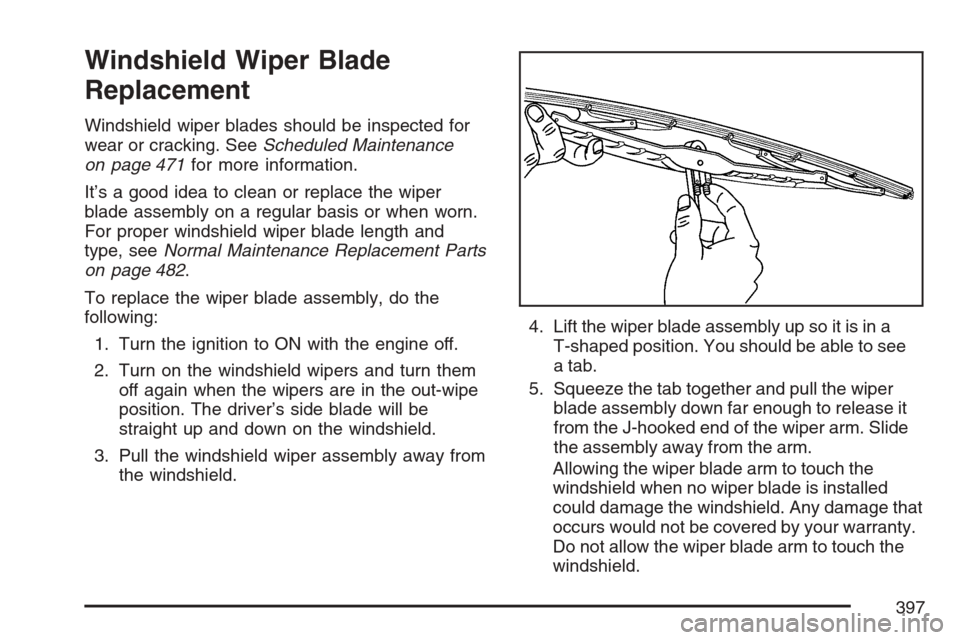
Windshield Wiper Blade
Replacement
Windshield wiper blades should be inspected for
wear or cracking. SeeScheduled Maintenance
on page 471for more information.
It’s a good idea to clean or replace the wiper
blade assembly on a regular basis or when worn.
For proper windshield wiper blade length and
type, seeNormal Maintenance Replacement Parts
on page 482.
To replace the wiper blade assembly, do the
following:
1. Turn the ignition to ON with the engine off.
2. Turn on the windshield wipers and turn them
off again when the wipers are in the out-wipe
position. The driver’s side blade will be
straight up and down on the windshield.
3. Pull the windshield wiper assembly away from
the windshield.4. Lift the wiper blade assembly up so it is in a
T-shaped position. You should be able to see
a tab.
5. Squeeze the tab together and pull the wiper
blade assembly down far enough to release it
from the J-hooked end of the wiper arm. Slide
the assembly away from the arm.
Allowing the wiper blade arm to touch the
windshield when no wiper blade is installed
could damage the windshield. Any damage that
occurs would not be covered by your warranty.
Do not allow the wiper blade arm to touch the
windshield.
397
Page 398 of 522
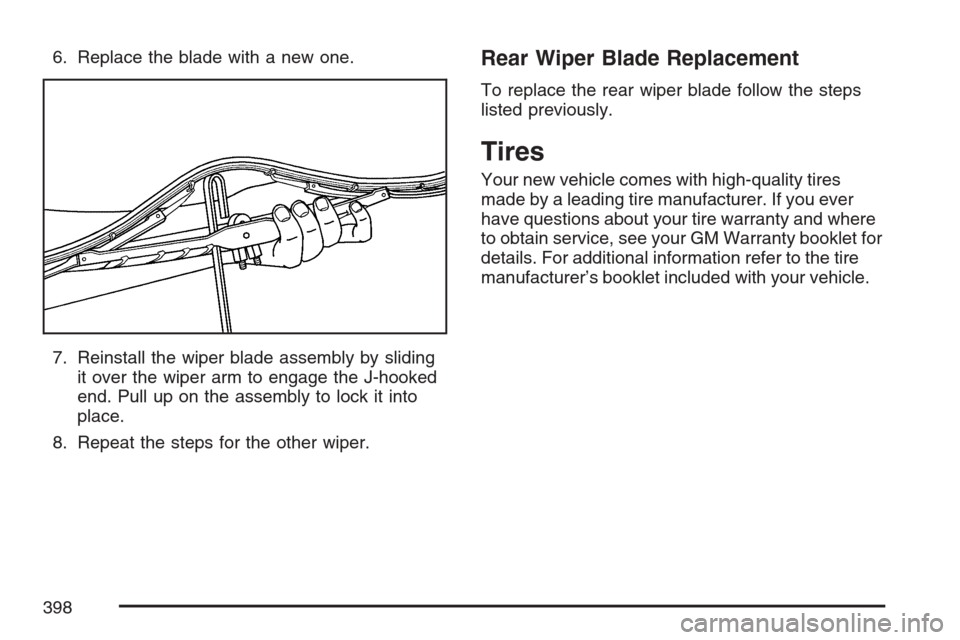
6. Replace the blade with a new one.
7. Reinstall the wiper blade assembly by sliding
it over the wiper arm to engage the J-hooked
end. Pull up on the assembly to lock it into
place.
8. Repeat the steps for the other wiper.Rear Wiper Blade Replacement
To replace the rear wiper blade follow the steps
listed previously.
Tires
Your new vehicle comes with high-quality tires
made by a leading tire manufacturer. If you ever
have questions about your tire warranty and where
to obtain service, see your GM Warranty booklet for
details. For additional information refer to the tire
manufacturer’s booklet included with your vehicle.
398
Page 399 of 522
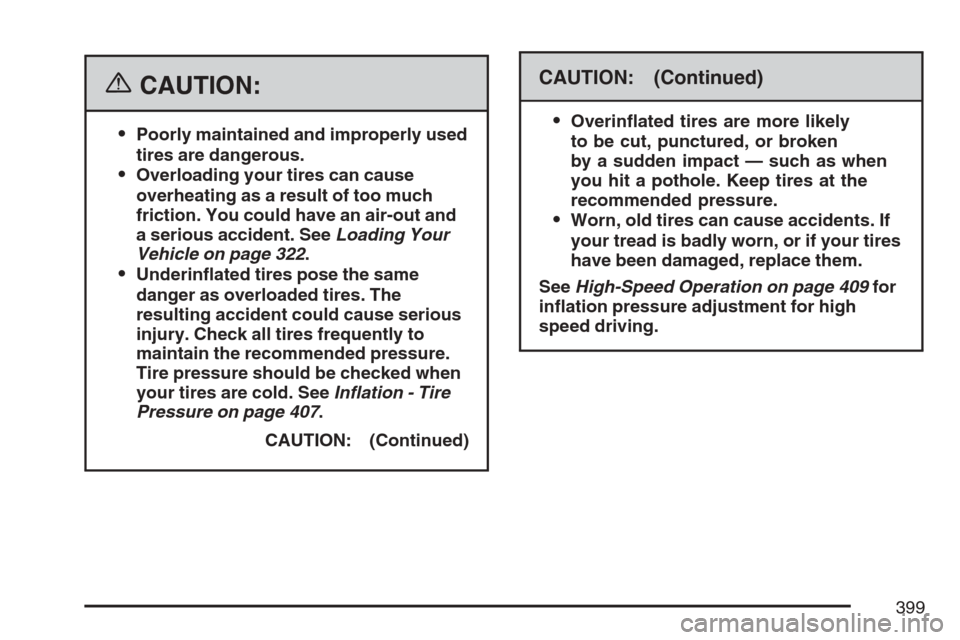
{CAUTION:
Poorly maintained and improperly used
tires are dangerous.
Overloading your tires can cause
overheating as a result of too much
friction. You could have an air-out and
a serious accident. SeeLoading Your
Vehicle on page 322.
Underin�ated tires pose the same
danger as overloaded tires. The
resulting accident could cause serious
injury. Check all tires frequently to
maintain the recommended pressure.
Tire pressure should be checked when
your tires are cold. SeeInflation - Tire
Pressure on page 407.
CAUTION: (Continued)
CAUTION: (Continued)
Overin�ated tires are more likely
to be cut, punctured, or broken
by a sudden impact — such as when
you hit a pothole. Keep tires at the
recommended pressure.
Worn, old tires can cause accidents. If
your tread is badly worn, or if your tires
have been damaged, replace them.
SeeHigh-Speed Operation on page 409for
in�ation pressure adjustment for high
speed driving.
399
Page 400 of 522
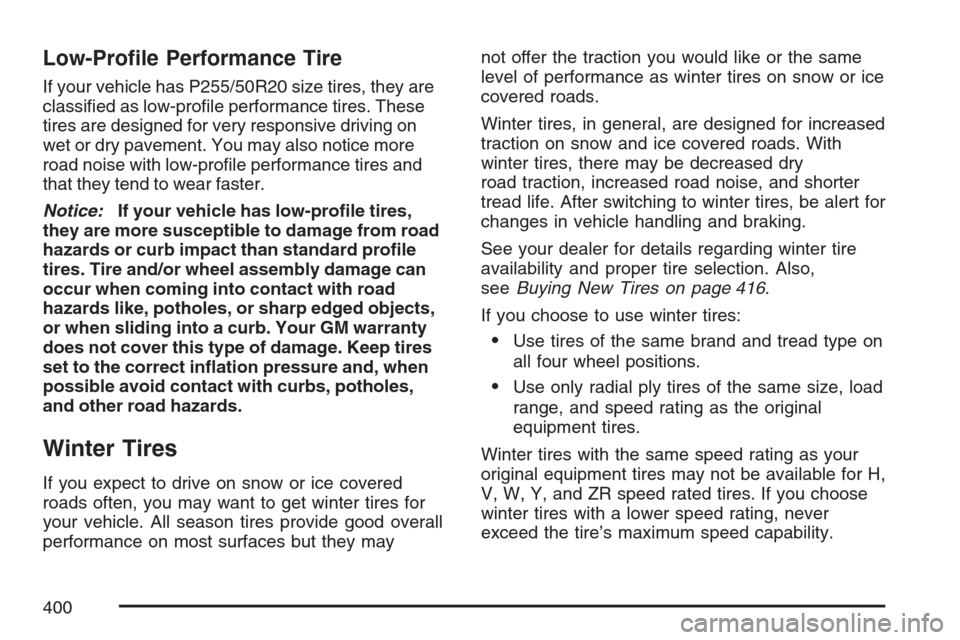
Low-Pro�le Performance Tire
If your vehicle has P255/50R20 size tires, they are
classi�ed as low-pro�le performance tires. These
tires are designed for very responsive driving on
wet or dry pavement. You may also notice more
road noise with low-pro�le performance tires and
that they tend to wear faster.
Notice:If your vehicle has low-pro�le tires,
they are more susceptible to damage from road
hazards or curb impact than standard pro�le
tires. Tire and/or wheel assembly damage can
occur when coming into contact with road
hazards like, potholes, or sharp edged objects,
or when sliding into a curb. Your GM warranty
does not cover this type of damage. Keep tires
set to the correct in�ation pressure and, when
possible avoid contact with curbs, potholes,
and other road hazards.
Winter Tires
If you expect to drive on snow or ice covered
roads often, you may want to get winter tires for
your vehicle. All season tires provide good overall
performance on most surfaces but they maynot offer the traction you would like or the same
level of performance as winter tires on snow or ice
covered roads.
Winter tires, in general, are designed for increased
traction on snow and ice covered roads. With
winter tires, there may be decreased dry
road traction, increased road noise, and shorter
tread life. After switching to winter tires, be alert for
changes in vehicle handling and braking.
See your dealer for details regarding winter tire
availability and proper tire selection. Also,
seeBuying New Tires on page 416.
If you choose to use winter tires:
Use tires of the same brand and tread type on
all four wheel positions.
Use only radial ply tires of the same size, load
range, and speed rating as the original
equipment tires.
Winter tires with the same speed rating as your
original equipment tires may not be available for H,
V, W, Y, and ZR speed rated tires. If you choose
winter tires with a lower speed rating, never
exceed the tire’s maximum speed capability.
400